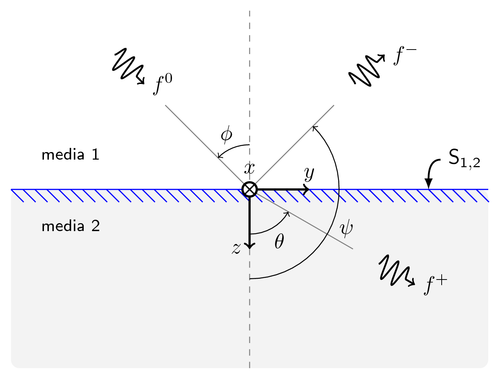Reflection and refraction of electromagnetic waves incident obliquely at plane interface.

Edit and compile if you like:
% Oblique Incidence with using basics instructions
% Author: Edgar Fuentes (Club de LaTeX UC member)
\documentclass{article}
\usepackage{tikz}
\usetikzlibrary{%
decorations.pathreplacing,%
decorations.pathmorphing%
}
\begin{document}
\pagestyle{empty}
\begin{tikzpicture}[
media/.style={font={\footnotesize\sffamily}},
wave/.style={
decorate,decoration={snake,post length=1.4mm,amplitude=2mm,
segment length=2mm},thick},
interface/.style={
% The border decoration is a path replacing decorator.
% For the interface style we want to draw the original path.
% The postaction option is therefore used to ensure that the
% border decoration is drawn *after* the original path.
postaction={draw,decorate,decoration={border,angle=-45,
amplitude=0.3cm,segment length=2mm}}},
]
% Round rectangle
\fill[gray!10,rounded corners] (-4,-3) rectangle (4,0);
% Interface
\draw[blue,line width=.5pt,interface](-4,0)--(4,0);
% Vertical dashed line
\draw[dashed,gray](0,-3)--(0,3);
% Coordinates system
\draw(0,0.15)node[above]{$x$};
\draw[<->,line width=1pt] (1,0) node[above]{$y$}-|(0,-1) node[left]{$z$};
% Incidence
\draw[->,wave]
(135:3.2cm)--(135:2.5cm)node[right]{$f^0$};
\draw[gray](0:0cm)--(135:2cm);
\path (0,0)++(113:1cm)node{$\phi$};
\draw[->](0,0.75)arc(90:135:.75cm);
% Transmission
\draw[->,wave]
(-30:2.5cm)--(-30:3.2cm)node[right]{$f^+$};
\draw[gray](0:0cm)--(-30:2cm);
\path (0,0)++(-60:1cm)node{$\theta$};
\draw[->] (0,-0.75) arc (-90:-30:.75cm);
% Reflection
\draw[->,wave]
(45:2.5cm)--(45:3.2cm)node[right]{$f^-$};
\path (0,0)++(-22:1.75cm) node{$\psi$};
\draw[gray](0:0cm)--(45:2cm);
\draw[->] (0,-1.5)arc(-90:45:1.5cm);
% Media names
\path[media] (-3,.6) node {media 1}
(-3,-.6) node {media 2};
% $x$ axis
\filldraw[fill=white,line width=1pt](0,0)circle(.12cm);
\draw[line width=.6pt] (0,0)
+(-135:.12cm) -- +(45:.12cm)
+(-45:.12cm) -- +(135:.12cm);
% Interface pointer
\draw[-latex,thick](3.2,0.5)node[right]{$\mathsf{S_{1,2}}$}
to[out=180,in=90] (3,0);
% To-paths are really useful for drawing curved lines. The above
% to path is equal to:
%
% \draw[-latex,thick](3.2,0.5)node[right]{$\mathsf{S_{1,2}}$}
% ..controls +(180:.2cm) and +(up:0.25cm) .. (3,0);
% Internally the to path is translated to a similar bezier curve,
% but the to path syntax hides the complexity from the user.
\end{tikzpicture}
\end{document}
Click to download: oblique-incidence.tex • oblique-incidence.pdf
Open in Overleaf: oblique-incidence.tex


